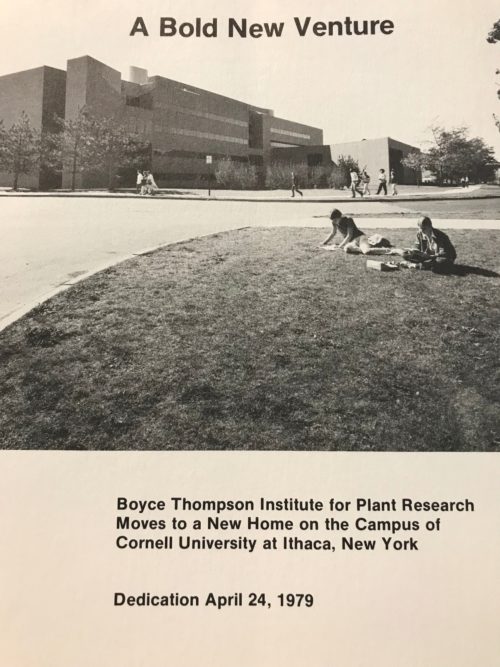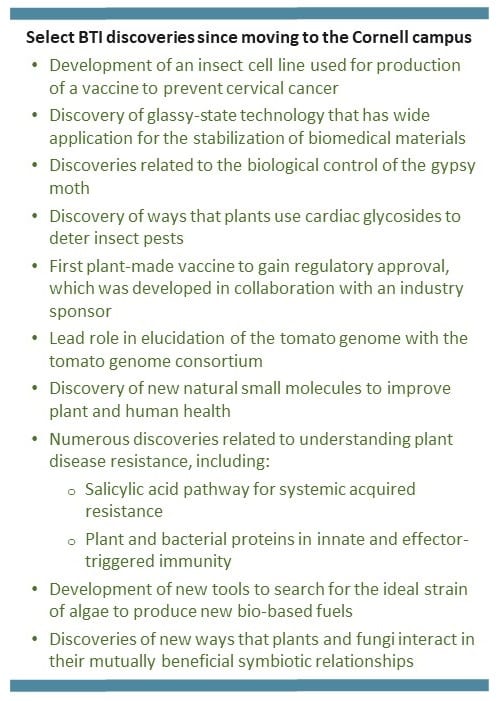News
BTI’s Big Red Anniversary: 40 Years at Cornell

The program cover for the dedication ceremony of Boyce Thompson Institute’s current facilities on the Cornell University campus.
The Boyce Thompson Institute of Corvallis, Oregon? It almost happened.
April 24 will mark the 40th anniversary of the dedication ceremony for BTI’s current facilities on the Cornell University campus in Ithaca, NY. The Institute’s researchers and staff will celebrate the milestone with cake and in remarks at events throughout the coming months, with gratitude to Cornell and a particular nod to New York State’s role in BTI’s move to its present location from Yonkers, NY.
Indeed, without the actions of then-Lt. Gov. Malcom Wilson and then-Assemblywoman Constance Cook, BTI likely would have landed in Oregon.
Prior to BTI’s founding in 1924, some of William Boyce Thompson’s advisers recommended that the plant science research institute be associated with a university. Instead, he built the Institute in Yonkers, directly across the street from his mansion.
Within a few decades, however, many BTI researchers began to push for a move to a university, citing a desire for more collaborative studies with other institutions, as well as increasing urbanization and pollution in Yonkers that adversely affected plant research.
BTI Emeritus Professors Alan Renwick and Bob Granados recall plenty of internal discussion about the Institute’s future during that time.
“I definitely agreed that we needed to move on from Yonkers,” says Renwick. “The property had become surrounded by commercial properties, and there was always a feeling that we should be associated with a university.”
Granados echoed the sentiment. “Our environmental biologists were finding more and more pollution in the air, and it was impacting their research,” he says. “The developing city was infringing on the science.”
George McNew, BTI’s Managing Director from 1949-1974, proved to be a shrewd negotiator, parlaying competing offers from Cornell and Oregon State University (OSU) against each other. In 1972, Cornell first pitched $6 million to build a facility on its campus for BTI, but the Institute would not have remained independent.
In early 1973, Oregon’s state legislature upped the ante by passing a bill to provide $6.75 million to build and equip facilities for BTI on the OSU campus. BTI leadership were so impressed following a visit to Corvallis, then-Board Chair William T. Smith signed a Memorandum of Agreement with OSU, making a move to Oregon practically a sure thing.
Once word of the OSU negotiations became public, Yonkers native Wilson and then-SUNY Chancellor Ernest Boyer convinced then-Gov. Nelson Rockefeller to try to keep BTI in New York State. Rockefeller introduced a bill into a special session of NYS legislature to provide $8.5 million to build and furnish BTI facilities on Cornell’s campus.
The bill cruised through the state senate 54-5, but encountered turbulence in the assembly until Cook used her leadership skills to get it passed.
 The additional $1.75 million provided by the state, plus Cornell’s agreement that BTI retain independence as an affiliate, swayed BTI’s board to vote unanimously for the Institute’s move to Ithaca.
The additional $1.75 million provided by the state, plus Cornell’s agreement that BTI retain independence as an affiliate, swayed BTI’s board to vote unanimously for the Institute’s move to Ithaca.
In September 1973, McNew sent a letter to OSU Vice President for Research Roy Young that made clear how important New York State’s efforts were to BTI’s decision:
“Had we not been a foundation incorporated in New York State, had the State political structure not shown such determination to retain us in this State or had Cornell and the State University of New York not been so perceptive in analyzing the worries and needs of our Board, there is no question but that we would have signed the agreement with OSU last Wednesday and probably broken off negotiations with Cornell.”
This decision was welcomed by most BTI faculty, including Granados. “Cornell’s reputation for agricultural science made it a no-brainer,” he says. “That was the place to be, that’s where all the action was. I heard the faculty vote was overwhelmingly in Cornell’s favor. Cornell wanted us, but we needed Cornell.”
BTI and Cornell executed an Agreement of Affiliation in May 1974, and the Institute was up and running in the new location by October 1978. Following the dedication ceremony the subsequent April, BTI held a two-day scientific symposium entitled, “Linking Research to Crop Improvement.”
“For the past 40 years, BTI and Cornell have enjoyed a unique, synergistic relationship that has benefitted the world-class research of both institutions,” says BTI President David Stern. “Most of our faculty also have appointments at the university, and Cornell grad students can obtain their degrees based on research performed here at the Institute.”
“We look forward to continue working on the Cornell campus to improve agriculture, protect the environment and enhance human health for the next 40 years and beyond,” Stern adds.
More details on BTI’s history can be found on our website.
Additional reporting by Keith Hannon

